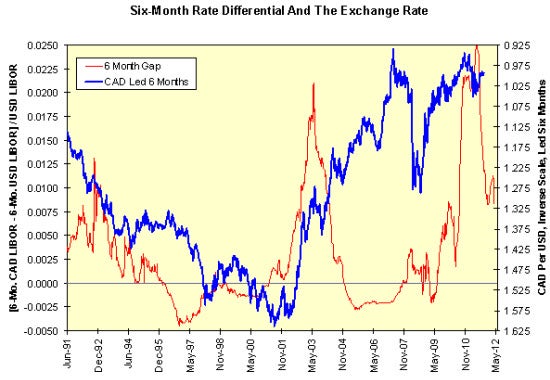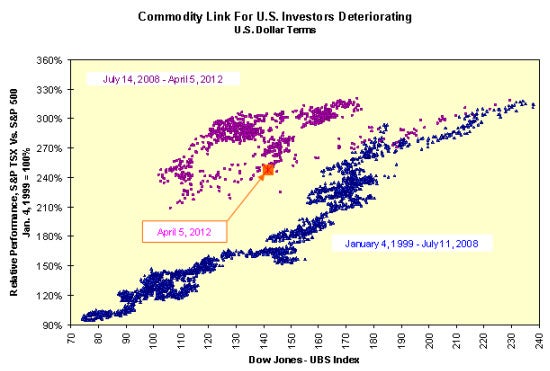By Howard Simons, Minyanville
Has the chaperone ever been the hero in popular culture? No, and if discussion of the relatively strong prospects by default for the US dollar could focus on the self-trashing by Japan and Switzerland and the foibles of the eurozone, Canada has to be excluded from consideration. The consequences for US investors in Canadian equities are negative as evidenced by the 4.3% return year-to-date for the iShares MSCI Canada Fund (EWC) as compared to a 12.1% gain for the Russell 3000 (IWV).
Higher Interest Rates Matter
Canada prides itself, rightfully, on dodging the brunt of the 2008-2009 financial crisis because it never went as overboard on a residential real estate bubble as did the US and others. As an aside, Federal Reserve Chairman Ben Bernanke does not think the US residential real estate bubble was a consequence of a deliberate attempt by his predecessor to create a real estate bubble, and celebrates homeowners' “extraction” of equity from their houses. Any institution wishing to study the principle of infallibility should pay a visit to Constitution Avenue.
Canadian short-term interest rates have been higher than their US counterparts since QE1, often stunningly so. There are many ways to illustrate this spread; let's use the rate gap between six-month Canadian dollar (CAD) and US dollar (USD) LIBOR divided by six-month USD LIBOR interest rate. This rate gap between two economies with so many trade and financial links has keep the Canadian dollar bid over the period and has led to downward pressures on the Canadian share of US external trade.
 Weakening Commodity Connection
The Canadian dollar and the relative performance of the Canadian stock market had been driven by the price of physical commodities for most of the past decade; it was in fact correct to call the Canadian dollar a “commodity currency.” That relationship is deteriorating; not only is the CAD becoming much more of a straight interest rate arbitrage play, but the relative performance of the Canadian market has been declining as a function of the Dow Jones-UBS index. As I note in the chart below, what had been a linear relationship between the two markets prior to the July 2008 commodity peak has turned into something far less deterministic.
Weakening Commodity Connection
The Canadian dollar and the relative performance of the Canadian stock market had been driven by the price of physical commodities for most of the past decade; it was in fact correct to call the Canadian dollar a “commodity currency.” That relationship is deteriorating; not only is the CAD becoming much more of a straight interest rate arbitrage play, but the relative performance of the Canadian market has been declining as a function of the Dow Jones-UBS index. As I note in the chart below, what had been a linear relationship between the two markets prior to the July 2008 commodity peak has turned into something far less deterministic.
 If we go back to the October 2011 global market low, the Basic Materials Select SPDR (XLB) has outperformed the Canadian resource sector rather handily. Of course, the area of greatest US outperformance has been in the technology sector thanks to the struggles of Research In Motion (RIMM).
As long as Canada keeps its short-term interest rates normal in an abnormal world, its financial markets will suffer from the chaperone complex: Everyone else is having a better time or at least pretending to.
More from Minyanville:
If we go back to the October 2011 global market low, the Basic Materials Select SPDR (XLB) has outperformed the Canadian resource sector rather handily. Of course, the area of greatest US outperformance has been in the technology sector thanks to the struggles of Research In Motion (RIMM).
As long as Canada keeps its short-term interest rates normal in an abnormal world, its financial markets will suffer from the chaperone complex: Everyone else is having a better time or at least pretending to.
More from Minyanville:
Random Thoughts: What Would Ron Burgandy Do?
Is the S&P Ready to Rock or Heading to 800? The Spiral Chart May Hold the Key
Four Steps to Solving Covered Call Risk
 Weakening Commodity Connection
The Canadian dollar and the relative performance of the Canadian stock market had been driven by the price of physical commodities for most of the past decade; it was in fact correct to call the Canadian dollar a “commodity currency.” That relationship is deteriorating; not only is the CAD becoming much more of a straight interest rate arbitrage play, but the relative performance of the Canadian market has been declining as a function of the Dow Jones-UBS index. As I note in the chart below, what had been a linear relationship between the two markets prior to the July 2008 commodity peak has turned into something far less deterministic.
Weakening Commodity Connection
The Canadian dollar and the relative performance of the Canadian stock market had been driven by the price of physical commodities for most of the past decade; it was in fact correct to call the Canadian dollar a “commodity currency.” That relationship is deteriorating; not only is the CAD becoming much more of a straight interest rate arbitrage play, but the relative performance of the Canadian market has been declining as a function of the Dow Jones-UBS index. As I note in the chart below, what had been a linear relationship between the two markets prior to the July 2008 commodity peak has turned into something far less deterministic.
 If we go back to the October 2011 global market low, the Basic Materials Select SPDR (XLB) has outperformed the Canadian resource sector rather handily. Of course, the area of greatest US outperformance has been in the technology sector thanks to the struggles of Research In Motion (RIMM).
As long as Canada keeps its short-term interest rates normal in an abnormal world, its financial markets will suffer from the chaperone complex: Everyone else is having a better time or at least pretending to.
More from Minyanville:
If we go back to the October 2011 global market low, the Basic Materials Select SPDR (XLB) has outperformed the Canadian resource sector rather handily. Of course, the area of greatest US outperformance has been in the technology sector thanks to the struggles of Research In Motion (RIMM).
As long as Canada keeps its short-term interest rates normal in an abnormal world, its financial markets will suffer from the chaperone complex: Everyone else is having a better time or at least pretending to.
More from Minyanville:Random Thoughts: What Would Ron Burgandy Do?
Is the S&P Ready to Rock or Heading to 800? The Spiral Chart May Hold the Key
Four Steps to Solving Covered Call Risk
EWCiShares MSCI Canada Index Fund
$38.41-5.44%
Edge Rankings
Momentum71.28
Growth-
Quality-
Value-
Price Trend
Short
Medium
Long
© 2025 Benzinga.com. Benzinga does not provide investment advice. All rights reserved.
Posted In:
Benzinga simplifies the market for smarter investing
Trade confidently with insights and alerts from analyst ratings, free reports and breaking news that affects the stocks you care about.
Join Now: Free!
Already a member?Sign in